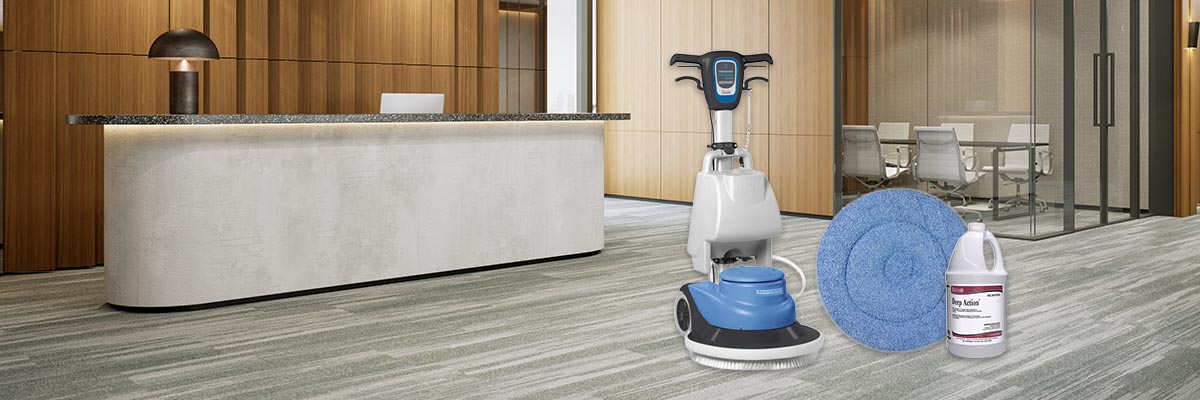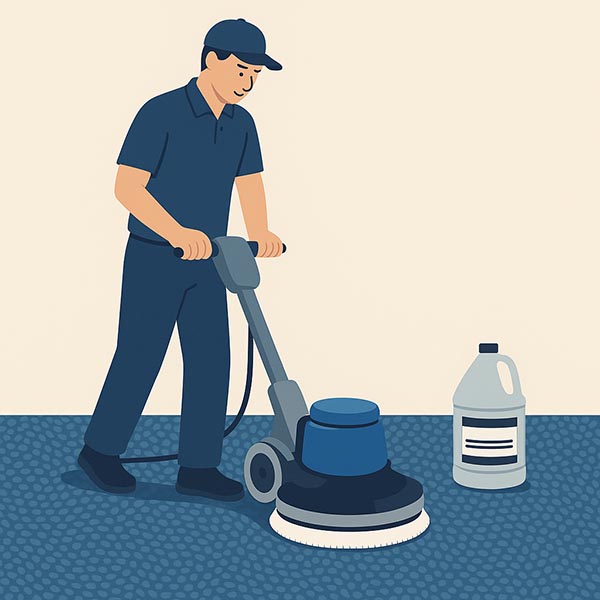How to use Carpet Bonnet Cleaning to Improve Heavy Traffic Areas
Carpet near entrances takes a beating. You see it every day. Dirt and debris build up quickly because many buildings use walk-off mats incorrectly or not at all. Carpet also gets deep cleaned far less often than hard floors. That gap shows up as dingy traffic lanes and worn-down carpet fibers. A good bonneting program keeps carpet looking better between deep extractions and helps protect your investment.
Additional Resources: Clean-In-Place Entry Matting

Why Bonneting Belongs in Your Plan
Hard floors get mopped or scrubbed often. Many facilities extract carpet once or twice a year. That means months of soil build-up between extractions. Bonneting fills the gap and removes the surface soil that makes carpet look dirty. It also reduces the amount of soil that reaches the backing, which can wear fibers out. With bonneting in place, you keep traffic lanes looking good, extend carpet life, and make full extractions more effective.
What You Need

Step by Step
- Move furniture if needed and vacuum the carpet thoroughly. Removing dry soil first improves your results.
- Place Wet Floor signs at all carpet to hard floor junctions.
- Use the Hillyard Spotting Kit and Spotting Chart to address any obvious discolored stains in the carpet. For more information on spot removal, see this article: The Ultimate Guide to Carpet Spot and Stain Removal.
- Mix Deep Action at 12 ounces per gallon of water in a pump sprayer.
- Pre-spray the carpet using 600 to 1000 square feet per diluted gallon. Let the solution dwell for 5 minutes. Work in a 500 to 1000 square foot area before spraying a new area.
- Dampen the bonnet by spraying it with diluted Deep Action and center it under the pad holder.
- Run the FMD20 orbital with attached bonnet over the pre-sprayed carpet allow about a 2-inch overlap to ensure complete bonneting of the carpet.
- Flip over the bonnet and dampen it with Deep Action when it becomes visibly soiled.
- When finished, empty the pump sprayer and thoroughly rinse its spray nozzle.
- Allow the carpet to dry completely before moving furniture back or allowing foot traffic. Use air movers to speed up the drying time.
- Once dry, vacuum the carpet again to lift the pile and remove encapsulated soil.
Additional Tips
- Bonnet heavy traffic lanes frequently to maintain appearance between extractions. Start with monthly cleaning and adjust the schedule based on your traffic levels.
- Frequent bonneting reduces deep soil buildup and makes your next extraction faster and easier.
- Always use clean bonnets and switch them out as soon as they show soil.
- Work toward the exit to avoid walking over freshly cleaned carpet.
- Keep walk-off mats clean and properly placed at every entrance so they capture dirt before it reaches your carpet. See this article for instructions: How To Keep Entry Matting Clean All Year Round.
Alternative to Bonnet Cleaning
Encapsulation Carpet Cleaning using the Trident ICS17 is a great alternative to bonnet cleaning. Both processes use Hillyard Deep Action, but the two counter rotating brushes on the ICS17 improves effectiveness by agitating both sides of the carpet nap while lifting and grooming the pile. Read this article to learn more: Encapsulation Carpet Cleaning: A low-moisture interim cleaning process
We Are Here to Help
You do not need to figure this out on your own. Hillyard has cleaning experts across the United States who can walk you through this process, recommend the right products, and set up a program that fits your facility. Our team can also train your staff on many other cleaning procedures to help you improve results and lower your overall cost to clean. Use the "I'm interested" form at the bottom of this page to get connected with your local Hillyard representative today.